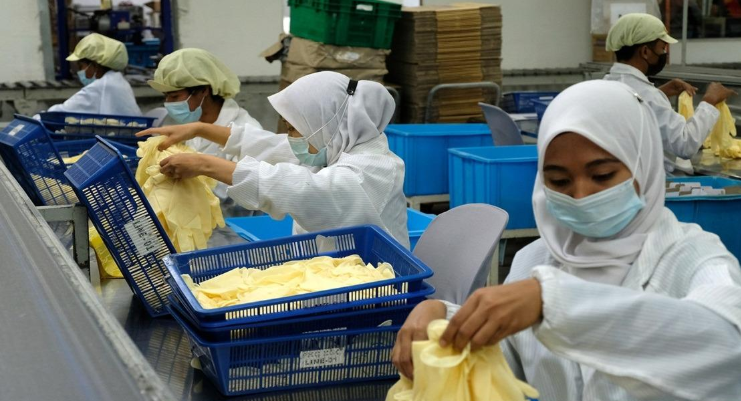Malaysia's PMI up in June, signalling improvement in manufacturing
 The seasonally adjusted S&P Global Malaysia Manufacturing Purchasing Managers’ Index (PMI) registered 50.4 in June, up from 50.1 in May, signalling a slightly stronger, yet still modest, improvement in the manufacturing sector.
The seasonally adjusted S&P Global Malaysia Manufacturing Purchasing Managers’ Index (PMI) registered 50.4 in June, up from 50.1 in May, signalling a slightly stronger, yet still modest, improvement in the manufacturing sector.
经季节性调整的标准普尔全球马来西亚制造业采购经理人指数(PMI)在 6 月录得 50.4,高于 5 月的 50.1,这表明制造业略有改善,但仍然温和。
The Malaysian manufacturing sector saw overall operating conditions improve at a slightly quicker rate halfway through 2022 and production levels stabilised for the first time following five consecutive monthly declines, while new orders rose for the third month running, albeit only fractionally.
到 2022 年中期,马来西亚制造业的整体运营状况以略快的速度改善,生产水平在连续五个月下降后首次企稳,而新订单连续第三个月上升,尽管只是小幅上升。
S&P Global Market Intelligence chief business economist Chris Williamson said Malaysia's manufacturers reported a steady but unspectacular end to the second quarter, underscoring how the economic recovery has lost some steam compared to the start of the quarter.
标准普尔全球市场情报首席商业经济学家Chris Williamson表示,马来西亚的制造商报告第二季度末稳定但并不引人注目,突显出与本季度初相比,经济复苏失去了一些动力。
“Companies are reporting sluggish export sales and growing concerns over the rising cost of living, especially in terms of rising energy and fuel prices.
“公司报告出口销售疲软,并且对生活成本上升的担忧日益增加,特别是在能源和燃料价格上涨方面。
"Both input costs and average selling prices are rising sharply again, suggesting inflationary pressures continue to build,” he said in a research note today.
“投入成本和平均售价再次大幅上涨,表明通胀压力继续增加,”他在今天的一份研究报告中表示。
He also said that while there was good news in terms of some supply constraints showing clear signs of easing which should help alleviate some industrial price pressures, global energy and food supply have become increasing sources of concern.
他还表示,虽然有一些供应限制显示出明显缓解迹象的好消息,这将有助于缓解一些工业价格压力,
但全球能源和食品供应已成为越来越令人担忧的来源。
Meanwhile, the ASEAN manufacturing sector recorded an improvement in operating conditions during June, according to the latest PMI data.
与此同时,根据最新的 PMI 数据,6 月份东盟制造业的经营状况有所改善。
Growth in output and new orders quickened compared to the previous survey period. However, manufacturing firms also reported renewed contractions in buying activity and employment.
与上一调查期相比,产出和新订单增长加快。然而,制造企业也报告称购买活动和就业再次出现收缩。
The headline PMI registered 52.0 in June, down slightly from 52.3 in May, to signal a solid overall improvement in the health of the ASEAN manufacturing sector.
6 月份的整体采购经理人指数为 52.0,略低于 5 月份的 52.3,表明东盟制造业的健康状况总体稳健改善。
Meanwhile, growth eased for the second month running, to the second-softest in the current nine-month sequence of expansion.
与此同时,增长连续第二个月放缓,在当前九个月的扩张序列中排名第二。
Six of the seven ASEAN nations signalled growth during June, with Singapore leading the rankings table for the seventh month running. Moreover, the rate of improvement (59.3) was marked and accelerated to a new series high.
东盟七个国家中有六个在 6 月份出现增长,新加坡连续第七个月位居榜首。此外,改善率(59.3)明显并加速至新的系列高点。
Commenting on the ASEAN Manufacturing PMI data, economist, Maryam Baluch said the latest PMI data signalled a further loss in growth momentum across the ASEAN manufacturing sector.
经济学家 Maryam Baluch 在评论东盟制造业 PMI 数据时表示,最新的 PMI 数据表明东盟制造业的增长势头进一步丧失。
“Firms, despite increasing production levels and receiving higher volumes of new orders, cut back on headcounts, holdings of raw materials and semi-finished items in June.
“尽管生产水平提高并收到更多新订单,但企业在 6 月份削减了员工人数、原材料和半成品的持有量。
“Growth slowed in four of the seven monitored nations in June while Myanmar recorded a decline. Surging inflation, raw material shortages and energy price hikes, impacted each region in one way or another,” she said in a separate statement.
“6 月份,七个受监测国家中的四个国家的增长放缓,而缅甸则出现下降。通货膨胀飙升、原材料短缺和能源价格上涨,以某种方式影响了每个地区,”她在另一份声明中说。
She added that nevertheless, sentiment was positive across the ASEAN manufacturing sector with panellists hopeful that output would expand in the coming 12 months.
她补充说,尽管如此,整个东盟制造业的情绪是积极的,小组成员希望未来 12 个月的产出会增加。
